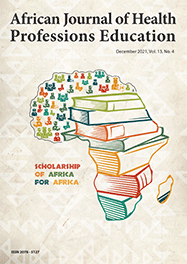Short Research Report

Bringing literature to life: A digital animation to teach analogue concepts in radiographic imaging during a pandemic - Lessons learnt
Abstract
Background: Teaching important, but ‘outdated’ technology (analogue) in a digital age is challenging as resources are rapidly phasing out. Combining that challenge with COVID-19 regulations and movement restrictions, educators needed to create meaningful and conducive learning experiences in the virtual classroom. To address this, lecturers in the Radiography department, created an animated video on automatic film processing (AFP) concepts, one with narration and one without. Students were then asked to engage with the animations to provide a description of the events they depicted in the form of an essay.
Objectives: To explore and describe students experiences of the online automatic film processing (AFP) animations as a learning tool.
Methods: A qualitative, descriptive exploratory design was adopted. A focus group interview was conducted with second year radiography students enrolled for the radiographic sciences module. Content analysis was used to analyse the data.
Results: Findings emerged from three themes, namely: AFP animation without narration can serve as an effective learning and assessment tool, animation with narration is a passive learning tool and recommendations to improve AFP concepts.
Conclusion: The animation without narration enabled the students to gain from inquiry based, experiential learning. However, the animation with narration and captions appeared to have a high cognitive load, hindering its effectiveness. The lessons learnt from this study is that although animations are deemed as an effective adjunct to teaching, active engagement is necessary for deep learning occur. Therefore, care must be taken when designing multimedia resources to ensure that effective learning takes place.
Authors' affiliations
H Essop, Department of Radiography, School of Healthcare Sciences, University of Pretoria, South Africa
IJC Lubbe, Department for Education Innovation, University of Pretoria, South Africa
M kekana, Department of Radiography, School of Healthcare Sciences, University of Pretoria, South Africa
Full Text
Cite this article
Article History
Date published: 2021-10-07
Article Views
Full text views: 1290




.jpg)
Comments on this article
*Read our policy for posting comments here